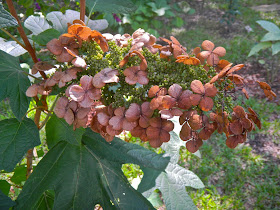 |
| A moth perches on daisies in front of the Education Center at the North Carolina Arboretum |
In mid-June, while motoring through the Southern Appalachian Mountains, I discovered the North Carolina Arboretum, located a short distance from my route. I spent part of my morning there ambling through the gardens.
The Arboretum charges a per vehicle fee which is waived for members. As I am not a member and was traveling alone, my admission fee was in effect $12 - several dollars more than I expected to pay.
Yet, after visiting, I'd do it again - and allow more time for exploring. The property includes 65 acres of cultivated gardens and more than 10 miles of hiking trails - far too much ground to cover in less than two hours. I did have time, however, to stop by the Heritage Garden, the Quilt Garden, the Stream Garden, the Bonsai Exhibition Garden, and the Plants of Promise Garden.
 |
| The Quilt Garden |
 |
Hydrangea maculata "Lisbelle"
|
 |
Shade loving Hosta "Allen P. McConnell"
|
 |
Spiky shapes and shadows add interest
|
 |
Plant markers identify species
|
 |
| A soothing waterfall fountain |
 |
| Wisteria vines wind up tree |
 |
Education Center porch
|
 |
| Daisies galore at the Entrance Plaza |
 |
Shade loving plants grow in front of the Baker Exhibit Center
|
 |
I'm a huge fan of Japanese maples
|
On my way back to the Interstate, I stopped by the Eden Brothers warehouse and went a little crazy buying seeds. That's what happens when a gardener leaves paradise.
 |
| The North Carolina Arboretum |













































